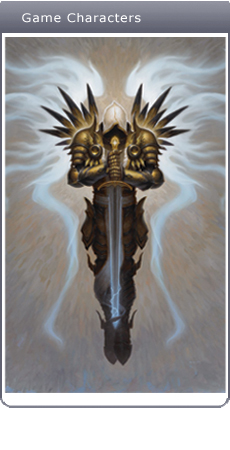 Home » Site News » WoW Introductory guide to f...
Home » Site News » WoW Introductory guide to f...
WoW Introductory guide to fighting hunters, Part 2
Tags : wow introductory guide, guide to fighting hunters, wow guide, wow news

Zach continues to take a closer look at the hunters themselves...
A hunter's basic repertoire of attacks consists of shots and stings, the former doing a variety of damaging effects and the latter applying a debuff. Although you only have to worry about one kind of sting being applied to you at any time, hunters have a sting for every kind of opponent. Serpent Sting is the most common, damaging sting, although they can also opt to use Viper Sting on mana-users or even Scorpid Sting against melee classes or other hunters. Stings are nature-based poison debuffs that can be removed by spells such as Cleansing Totems, Cleanse, and Cure Poison.
Most good hunters will try to keep a sting applied on a target, as it can confer benefits to the hunter beyond the basic debuff. Even with abilities to remove the debuff, stings can be reapplied almost immediately, so it can sometimes be a mana-intensive effort for both parties. Out of all the stings, hunters will protect and re-apply Viper Sting the most. On top of their sting, hunters also have a wide selection of ranged attacks. You can expect to be the target of their version of Mortal Strike, the marksmanship talent, Aimed Shot, or the Execute-like ability, Kill Shot, so always watch your health.
It's very difficult to get the element of surprise against a hunter, who will almost always have Track Humanoids active. Even against rogues, hunters have the option to use Flares, Track Hidden, and even Hunter's Mark if they get the chance. Tracking makes hunters ideal guards on flags in Arathi Basin or Warsong Gulch. Melee players should be wary of approaching a hunter because most will drop a Freezing Trap where they stand to counter rogue openers or warrior Charge.
Hunters also have the ability to shake off targeting by using Feign Death. Since it's no longer needed to drop traps, hunters can now use it as often as possible in order to confuse opponents. A /targetlasttarget macro is useful in these situations in order to reacquire the hunter. Expect this ability to be used frequently in PvP.
A note on mobility
A hunter is at his most powerful when sniping unmolested from a distance, which is why they thrive in the Battleground environment. In Alterac Valley, for example, hunters can easily find an elevated perch from where they can attack without fear of reprisal. They deal the most damage when they don't have to move at all, being able to weave Arcane Shots, Auto Shots, and Steady Shots without breaking their rhythm. In those cases, it's usually advisable to simply get out of range and try to engage them under more favorable conditions.
Regardless of spec -- even survival -- hunters are at a severe disadvantage when you take away their mobility. Applying snares such as Crippling Poison or Hamstring will impair their ability to kite, and constantly snaring them will frustrate them immensely. Remember that one of their best tools to create distance, Disengage, is a backwards leap, so it's always good to try and keep behind them and to make sure their backs are against higher ground. A disengage will end prematurely if a hunter hits an object on the way.
As powerful as hunters are, they have limited means to counter crowd control and so must be crowd controlled, ensnared, and rooted early and often to force them to blow their trinket or their cooldowns. Control a hunter's mobility, and you control the fight. Hunters more than any class rely on dictating the range of their encounters, usually at a 40-yard range where most spells won't reach them but where they can fire most of their attacks. They also have ensnaring tools of their own, such as Concussive Shot, which many hunters will use to slow their opponent's approach or escape. In melee range, they'll spam Wing Clip. Negate their ability to dictate range and you should be in a better position to dominate the match-up.
Tender traps
Trap mastery is a lost art. When Blizzard moved away from crowd control in dungeons and raids in recent content design, a lot of hunters were no longer required to use traps in instances, making it something of a forgotten skill. That said, traps see frequent use in PvP, with good hunters using them as often as possible. Familiarize yourself with their traps, such as a Freezing Trap, which is used to keep someone out of play. This won't often be seen in the Battlegrounds because of the uncoordinated attacks and DoTs which tend to break the trap prematurely, but it has the unique distinction of being the only trap that can be placed from long range through a Freezing Arrow.
Frost Trap is popular and hunters will throw this in the midst of a melee fracas to put their opponents at a disadvantage. When triggered, this is easily identifiable by the large, snowy graphics on the ground. Needless to say, don't step on it if you can manage it. The other popular trap in PvP is Snake Trap, which is a grab bag of sorts because the assorted snakes can apply different rogue poisons such as Crippling, Deadly, and Mind-Numbing Poisons. This is very easily countered by any AoE ability such as a Holy Nova, Consecration, or Arcane Explosion as the snakes have very low health. If you see snakes, pop an AoE. Explosive and Immolation Traps are used infrequently as most hunters in PvP will opt for utility over the damage.
Beast Mastery
Many beast mastery-specced hunters will be easy to spot. If they've gone 51 points deep and picked up the Beast Mastery talent, they will easily be identifiable through their exotic pets. Exotic pets include devilsaurs, chimaeras, core hounds, rhinos, silithids, spirit beasts, and worms. These pets are similar to other regular pet families but have a bit of an added bonus to their special abilities. Casters in particular should watch for core hounds and their Lava Breath, which slows down casting time. Other PvP effects include a chimaera's Froststorm Breath, which ensnares, and a silithid's Venom Web Spray, which roots. Other exotic pets offer nothing particularly exciting in PvP.
A beast master is most fearsome with any pet, however. Even if they don't sport an exotic one, they will be unmistakable on the battlefield when they activate Bestial Wrath; the hunter will also almost always have the Beast Within. Casters are all too familiar with the nightmare of a ferocious, giant red pet clawing, biting, and stunning them silly while the hunter does his damage from afar. There are basically two options when that happens -- get away from the hunter and his pet for 10 seconds, or pour on as much damage as possible to the hunter.
Hunters with Beast Within active are immune to all forms of crowd control, so they need to be fled from or killed. At worst, you can also use defensive cooldowns and maybe even be forced to use a trinket as they're also likely to send their pet to use Intimidation. As with most important cooldowns, a BM hunter is most vulnerable after they've blown theirs. It's kind of like a paladin's Divine Shield.
Since BM hunters don't need to use traps as often, many of them won't. They will rely heavily on their pets and the best ones will have special abilities off auto-cast and keybound. While disabling the pet seems like a logical idea, Beast Mastery also has the best tools to protect them. Be cautious when engaging them and always try to bait them into using Bestial Wrath / Beast Within. This is their trump card. Survive this and you will have removed the greater part of the danger they pose.
Source: wow.com
Fast Order
| USD EUR GBP AUD CAD | |
 | |

Shopping Cart
Contact us
Teams/Skype (sell to us) :selltoallen
Email: [email protected]
Discord:gameim#1112
Discord:Gaimugold#1567
Use of this Web site constitutes acceptance of the [ TERMS & CONDITIONS ] and [ PRIVACY POLICY ]
Copyright © 2007-2015, mmogarden Inc. All Rights Reserved.


